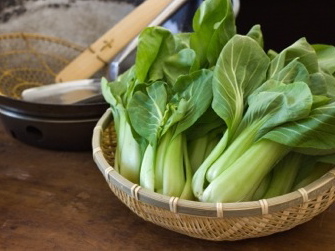
reference-image, l
(article, Amy Sherman)
[%adInjectionSettings noInject=true] Which would you rather eat: Chinese food, or authentic Chinese food? Like the words "artisanal" and "natural," “authentic” has come to mean something desirable. But all three terms are nebulous. Does “authentic” in this case refer to cooking techniques, equipment, ingredients, chefs, or recipes? Or some combination thereof? When it comes to recipes in a cookbook, “true to the original” is probably a good definition of “authentic.” But choosing the dishes that fit this definition is tricky. Three recently published cookbooks focused on Chinese cuisine for home cooks could all be called “authentic,” but in different ways. One is filled with recipes based on restaurant dishes, while another contains recipes from a specific region of China. The third uses traditional ingredients and techniques with occasional non-traditional substitutions to create “simplified” recipes. Michael Tong, the owner and executive chef of Shun Lee West and Shun Lee Palace in New York City, is the author of the The Shun Lee Cookbook. The recipes in his book are a combination of classics (Crispy Orange Beef, Dry Sautéed String Beans, Kung Pao Shrimp, Scallion Pancakes), Chinese-American favorites (Sesame Shrimp Toast), and other Chinese and Chinese-influenced dishes (Singapore-style Rice Noodles with Curry). I loved Tong’s recipe for Lion's Head Meatballs: braised meatballs lightened with tofu and cooked with Napa cabbage. The finished product resembles a lion's mane, but I felt the soupy sauce needed to be reduced. Still, for recreating restaurant-style Chinese food, the Shun Lee Cookbook is a good pick. Of the three cookbook authors, Fuchsia Dunlop is both the only one not Chinese by birth and the one most dedicated to preserving Chinese culinary traditions. Dunlop studied Chinese cooking at one of the top cooking schools in China, the Sichuan Higher Institute of Cuisine; she also speaks Mandarin. Unlike the other authors, she does not have restaurant experience. The recipes in Dunlop's book, Revolutionary Chinese Cookbook, come from the province of Hunan. Dunlop details the history of Hunanese cooking, discussing the turbulent last century in particular. Her recipes range from sophisticated banquet dishes, such as Junshan Steamed Fish in Rice Meal, to the more rustic peasant dishes that were favorites of Chairman Mao, such as Red-Braised Pork. She includes street snacks (Changsha Cold Tossed Noodles), home-cooked dishes (Duck Egg and Chive Omelet) and even a restaurant specialty (General Tso’s Chicken) brought to the United States by a Hunanese chef, who learned to cook in Taiwan while stationed with the Nationalist army. Dunlop’s recipes are the most challenging in terms of techniques and ingredients. But any city with a large Asian population should have a market where you can find everything you need, and Dunlop’s recipe instructions are clear and easy to understand. “Authentic” doesn’t always mean “true.” Both Tong and Dunlop retell the story of how the dish General Tso's Chicken came into existence. But which recipe is more authentic? And who really introduced it to America? Dunlop claims it was a Hunanese chef, Peng Chang-kuei, who introduced General Tso’s Chicken at his restaurant in New York in the early 1970s. He altered the recipe he learned in Taiwan to please non-Hunanese palates by adding sugar. Now the dish has been reintroduced in Hunan, although it was first popularized by exiled Hunan chefs living in Taiwan. [%image reference-image float=right width=400 caption="Chinese home cooking." credit="Photo: iStockphoto/YinYang"] Michael Tong claims that he and fellow chef Tsung Ting Wang introduced the dish to New York in the 1970s. The Shun Lee Cookbook calls the recipe Chengdu Chicken, after the capital city of Sichuan, while Dunlop shares two recipes for the dish: one called Taiwan Style, the other Changsha Style, after the capital of Hunan. Clearly, this is a dish open to interpretation. And what about poor General Tso himself? He lived around 1850, and no record from that time has been found of his supposed favorite dish. Kylie Kwong is a fourth-generation Australian. She’s a restaurant cook and a TV personality with two cooking programs on the Discovery Home Channel. Her mission in her latest book, Simple Chinese Cooking, is to make cooking Chinese food at home easy. Her recipes use ingredients commonly found in supermarkets and unfussy techniques. [[block(sidebar). h1.Featured recipes]] Kwong is unafraid to innovate. In one recipe, she incorporates her love for salad into a traditional Ma Po Tofu dish of spicy tofu and round pork. The cooling elements of shredded iceberg lettuce and sliced tomatoes are, as she is the first to admit, unusual. But they work. The dish, very much like the book, is fresh, inspired, and delicious. Making recipes work for current times and tastes is nothing new; it’s been done for centuries. Innovation doesn’t necessarily destroy the authenticity of a dish. Sometimes, in fact, it ensures its popularity and longevity. And occasionally a whole new classic is created instead. p(bio). Amy Sherman is a writer, recipe developer, and restaurant reviewer in San Francisco. She is the editor of Cooking with Amy, a food blog, and recently wrote the introduction to the American reprint of Jane Grigson's Vegetable Book.

reference-image, l